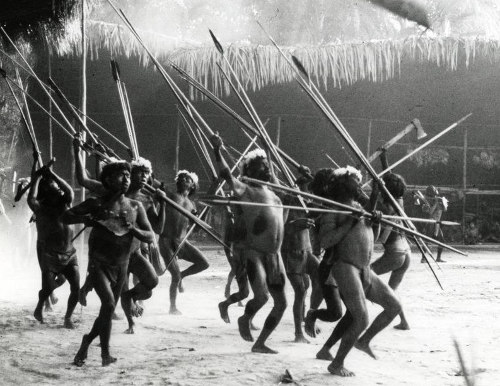
In 1964, anthropologist Napoleon Chagnon arrived in an almost entirely unexplored region of the Amazon Basin to spend a year studying the Yanomamö: one of the last large, isolated, and virtually uncontacted tribes in the world.
Over the next 35 years, Chagnon returned to this area on the border between Venezuela and Brazil 25 times and lived among this primitive people for a total of 5 years. He spent his time there intimately and exhaustively detailing the lives of 25,000 Yanomamö who lived in 250 separate villages in a way nearly unchanged from how humans existed for tens of thousands of years before the modern era. His education in anthropology had not prepared him for what he would observe. While he had been taught that tribal peoples were mostly peaceful, Chagnon found that war was a nearly constant state of affairs for the Yanomamö that shaped every aspect of their lives and culture. While his textbooks and professors had said that when tribes did fight, the battles were rooted in conflicts over material resources, Chagnon found that the Yanomamö’s wars were almost entirely over women. And while Chagnon had believed that all tribal peoples were highly egalitarian, he found that Yanomamö men were in fact very concerned about status and that there were several ways for a man to elevate himself above his village peers.
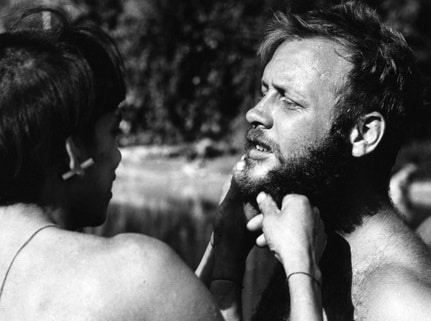
Napoleon Chagnon and a Yanomamö tribesman
Chagnon describes these revelations and the controversy they caused in the anthropological world in his recent book, Noble Savages. While every tribe around the world and throughout history has had their own distinct culture, what Chagnon observed about the Yanomamö are traits that have been recorded in many other primitive peoples as well, and what I found most interesting about this quite fascinating book is the way many of his observations related to the tenets of honor we discussed in our series on the subject last year. (Quick review: classical honor is defined as a reputation worthy of respect and admiration.) In that series, we talked about the way the code of honor for men has evolved, from bravery and physical prowess to virtue and character, while its basic mechanisms for achievement and enforcement have remained the same. By taking a look at how honor operated among the Yanomamö, we can discover specific examples of some of the principles which we previously described in the abstract, as well as a possible explanation of how and why the basic masculine code of honor-as-courage developed in the first place. At the same time, it causes us to reflect on how this primitive code of honor still echoes faintly in the present. For while the lives of tribes like the Yanomamö can seem light years away from our own, in the long sweep of history, men lived like them far longer than they have lived like us; the many centuries the world has experienced modern civilization is really a blink of an eye in the grand scheme of things. So how did men live and earn honor in, as Jared Diamond would put it, “the world until yesterday?â€
A State of War
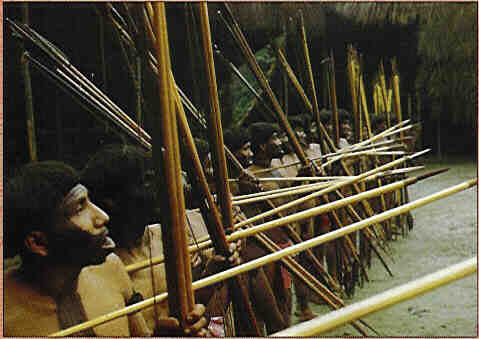
Chagnon’s first big surprise when he arrived among the Yanomamö was that the tribe existed in a state of chronic war — their lives were overhung with the “ubiquity of terror.†Chagnon’s education in anthropology had largely presented him with an image of primitive tribesmen as Roussean “noble savages†– communal, peace-loving people who were one with nature and each other. Warfare, his fellow anthropologists argued, was largely the product of capitalist exploitation and colonization, and tribes had experienced very little conflict until disrupted by contact with industrialized nations. This academic image would collide sharply with what Chagnon found in the field. “While it is also true that tribesmen spend many happy hours hunting, fishing, gathering, and telling wonderful stories and myths around the campfire,†Chagnon writes, “one of the most salient features of their social environment is the threat of attack from neighbors.â€
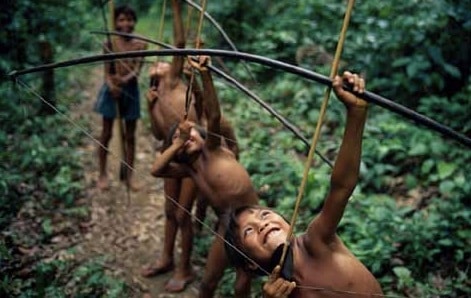
This fear of attack was not an unfounded worry; early morning raids by neighboring villages happened with some frequency and the results were often fatal. Through his meticulous research and data-keeping, Chagnon found that in 1988, “two-thirds of all living Yanomamö over the age of forty [had] lost one or more close genetic kinsman—a father, brother, husband, or son—to violence.†In comparison, around one-sixth of Britons lost a member of their immediate family in the famously bloody Great War. This of course means that the percentage of Yanomamö men who had killed another was also quite high; Chagnon discovered that 45% of these tribesmen had slain at least one other man.
Chagnon argues that other anthropologists had underestimated the violent nature of tribal cultures because their fieldwork had been done with tribes that had already changed their way of life due to contact with outsiders; there were very few uncontacted, “demographically intact†tribes left to study at the time – places “where populations of tribesmen were still growing by reproducing offspring faster than people were dying and were fighting with each other in complete independence of nation states that surrounded them.â€
From his fieldwork, and looking at the history of other tribes around the world, Chagnon theorized that war, far from being the product of capitalist exploitation and colonization was in fact the true “state of nature.†He concluded that 1) “maximizing political and personal security was the overwhelming driving force in human social and cultural evolution,†and 2) “warfare has been the most important single force shaping the evolution of political society in our species.â€
Fighting Over Women
If Chagnon was surprised to find that the Yanomamö were not the peace-loving noble savages he had expected, he was equally surprised to learn the cause of their constant conflict.
Chagnon’s education in anthropology had stressed that primitive peoples only went to war over material resources – land, food, oil, water, wealth, etc. – just like industrialized nations did. What Chagnon discovered in the field was the Yanomamö did indeed fight over a scarce resource, but it was one his contemporaries completely dismissed: women.
Chagnon argues that the Yanomamö were driven by a biological desire to pass on their genes just as other animals were, and that their conflicts were almost entirely rooted in reproductive competition. “The tokens of wealth that we civilized people covet are largely irrelevant to success and survival in the tribal world and were irrelevant during most of human history,†Chagnon writes. “But women have always been the most valuable single resource that men fight for and defend.â€

Yet the Yanomamö’s desire to obtain a woman with which to sire progeny was not simply a biological imperative, but also related to the third surprise to come out of Chagnon’s fieldwork: the tribesmen’s desire for status and honor.
Because primitive tribes didn’t have much in the way of material wealth, Chagnon’s fellow anthropologists believed that their cultures were very egalitarian in nature. Which is to say, the only status differentiators were thought to come down to “automatic†designations rooted in sex or age; older people had higher status than younger folks, and men had higher status than women, but there was nothing individuals could do to elevate themselves above their peers in order to attain “vertical honor.â€
In contrast, Chagnon found some Yanomamö men were more prominent and given more deference than others. These men attained a greater degree of honor in several ways. First, the men with the most kin and the largest patrilineage enjoyed higher status, and Chagnon observed “that the political leaders in all Yanomamö villages almost always have the largest number of genetic relatives within the group.†They were also at an advantage when it came to perpetuating this higher status; the more male relatives a young man had, the easier it was for him to successfully find a wife. A young man’s father and older male relatives would help him find a spouse, and other men in the village preferred to give their daughters in marriage to those who came from prominent lineages anyway. This, Chagnon argues, is in fact the main function of patrilineages: “What these Yanomamö descent groups control and defend are reproductive rights in nubile females and the male kin who give these women to you and take them from you.â€
The Yanomamö, like most tribes in history, practiced polygamy (more accurately polygyny – only men could have multiple spouses), and every Yanomamö man hoped to have multiple wives. Yet this privilege was largely reserved for men of higher status. The problem with polygyny, of course, is that if some guys have six wives other guys will have none. Polygyny created a scarcity in women, which is why females – the key to reproductive success – became the one resource worth fighting over. A group of men from one village might raid another village to bring back some of their women; Chagnon found that 20% of the women in the villages he studied had been abducted from other villages. These raids could then set off a cycle of retaliatory violence; if the original raiding party killed someone during their abduction mission, men from the raided village would plan a counterattack to even the score. Back and forth it would go, creating the aforementioned conditions of constant “war†and fear of attack.
From his observations of the pervasiveness of female-rooted conflict, Chagnon theorized that “if we viewed the human ability to harness, control, and prudently deploy violence for reproductive advantage, we could consider this skill the most important of all strategic resources,†and that need to regulate the deployment of this resource is what gave birth to social as well as political rules and laws. He summarizes his conclusions thusly:
“Regardless of their marital status, most Yanomamö men are trying to copulate with available women most of the time, but are constrained from doing so by the rules of incest and the intervention of some other man with proprietary interests in the same women. This is why there is so much club fighting and why villages split into two or more groups so easily. Conflicts over the possession of nubile females have probably been the main reason for fights and killings throughout most of human history: the original human societal rules emerged, in all probability, to regulate male access to females and prevent the social chaos attendant on fighting over women. Males in this persistent kind of social environment sought the help of other related males—brothers, sons, cousins, uncles, nephews—and formed male coalitions to pursue their selfish reproductive goals as well as to minimize lethal conflicts within their own groups.â€
Courage and Fierceness
At last we come to answering the question of how the most basic form of the male honor code came to revolve around prowess and courage. Here Chagnon’s observations are especially interesting, and we will make ample use of them.
The Yanomamö were interested both in maintaining the honorable reputation of their village as a whole, and as individual men within it.
Village-Wide Honor
As the Yanomamö lived in constant fear of an attack and the abduction of their women by a neighboring village, it was crucially important that not only were the men of each village prepared to fend off such an attack, but that the village as a whole had the kind of reputation that made other villages think twice about even attempting a raid. The maintenance of honor was thus a group project; each individual man in a village, if he wished to earn “horizontal honor,†had to do his part to project and demonstrate courage and fierceness (“The Fierce People†was a “phrase the Yanomamö themselves frequently used to emphasize their valor, braveness, and willingness to act aggressively on their own behalf.”) If individual men didn’t pull their weight, and evinced fear and timidity instead, this showed weakness, damaged the village’s reputation for strength, and essentially invited attack. Chagnon explains further:
“Let me emphasize the Yanomamö view that when members of a group acquire a reputation of timidity and cowardice, their neighbors take ruthless advantage of them, push them around, insult them publicly, and take their women. Thus it is strategically important to react decisively to any affront, no matter how trivial. If a group is small, the men try to make up for their numerical disadvantage by acting as if the group is bigger, nastier, more ferocious, and ready to fight on a moment’s notice. Feigning to be “larger than life†is a deception that is widespread in the animal world but is usually a characteristic displayed by individual combatants. The Yanomamö, however, engage in this masquerade as members of social groups. I often deliberately avoided visiting small villages because they were predictably very aggressive and unpleasant to be around in order to compensate for their actual military weaknesses.â€
As Chagnon notes, since reputation-maintenance is so important, villages are quick to address any perceived insults as to their manliness, strength, and courage from other villages. Because they don’t want such “offensive rumors†spreading around, “they are immediately addressed by a ‘we’ll show you’ melee.†The Yanomamö have varying degrees of these honor-defending contests that correspond to the seriousness of the insult received.
If one village feels that another has been unfairly spreading gossip about their timidity and weakness, but the insults have not been too serious in nature, the two villages will agree to resolve the issue with a good-natured fight, often when one is visiting the other for a feast. These free-for-alls consist of the men slapping (using a closed fist is considered unfair) each other’s sides, pulling each other’s hair, and wrestling in the mud and dirt. The younger men participate while the older men circle around, waving their axes and machetes, yelling instructions to the fighters, and keeping the skirmish from developing into a more serious fight. The young men hurt each other, but generally avoid causing severe injuries, and after about 40 minutes the fight breaks up. Nobody is declared the winner but the intention of the melee is fulfilled:
“The whole purpose of the fight just seems to be to set the record straight as far as rumors of cowardice or unwillingness to fight. When the young fighters regain their breath and composure, they quietly and unceremoniously get to their feet, go outside the shabono to clean up and wash their bodies, maybe even take a leisurely swim in the nearby creek. There seem to be no obvious hard feelings afterward and the more ceremonial events like eating, trading, chanting, and dancing proceed as though the fight had never happened. But they have now sized up each other and are better informed regarding just how far they can push or intimidate each other in the future without triggering an unanticipated and more serious reaction. And they usually learn the possible costs of spreading false rumors about people who are feasting with them.â€
If a village feels it has been more seriously insulted, they may challenge the rumor-generating village to a more formal chest-pounding or side-slapping duel. In the former contest, two men face off. One agrees to take the first blows and offers his chest to his opponent as he gazes manfully into the distance. His opponent winds up like a baseball pitcher and delivers several powerful overhand blows to his pectoral muscles. The men then switch roles, and the guy who just got beaten can now deliver the same number of blows to his opponent’s chest. The goal is to bear the blows as stoically as possible and make your opponent cry “uncle†first. A side-slapping duel works much the same way, with the two fighters squatting and kneeling and brutally slapping each other “on the flanks between the rib cage and the pelvis, with an open hand.†In both kinds of duels, the fighters become deeply bruised and sore, and injuries to one’s internal organs can occur; lung tissue is damaged and kidneys tenderized. Occasionally duelists do die from their injuries, but the contests are designed to be a nonlethal means to address honor-impinging insults.
In response to the most serious kinds of slander, as well as things like tobacco and food theft or another man trying to seduce or abduct one’s wife, a club fight becomes the appropriate means of redress. Like in the aforementioned duels, two men square off, and one delivers the first blow — arcing the end of his club all the way from the ground, through the air, and square on top of his opponent’s head. The recipient of the wallop is tasked with bearing the blow stoically, and attempts to remain motionless while leaning on his own club for support. Now the recipient of the first blow, often with “large chunks of their scalp bashed loose, flapping up and down on their crania,†gets to deliver one in turn to his opponent. Club fighting matches start with two duelists, but may progress into all out melees where numerous men grab their clubs and start swinging them at each other with abandon.
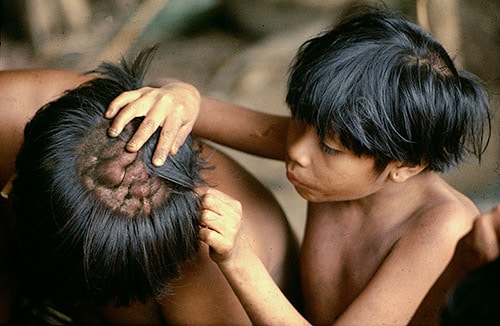
Scars from club fighting.
“Many accomplished and persistent club fighters have scalps that are crisscrossed with as many as a dozen huge, protuberant, lumpy scars two or three inches long after their scalps are healed,†Chagnon observed. And they’re proud of these scars:
“Men with numerous club-fighting scars like these are not bashful about displaying them prominently. They shave the tops of their heads in a tonsure and then rub red pigment into their numerous deep scars, to exaggerate them. Such a man, if he lowers his face and head to you, is usually not showing deference: he is conspicuously advertising his fierceness.â€
Despite that fact that death was sometimes the result of these different degrees of duels and melees, “none of the fighting…is intentionally lethal,†Chagnon explains, and should rather be classified as “deliberately sublethal ‘alternatives’ to warfare.†Just like the “affairs of honor†and “rough and tumbles†engaged in by men of the 19th century, the fights were not specifically designed to kill, but were a means for a man, or a group of men, to show they were unafraid to fight and bleed in order to maintain their honorable reputation.
Individual Honor
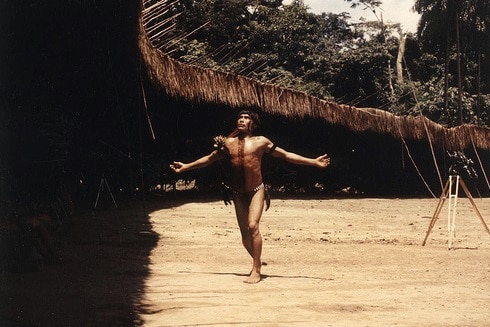
While individual Yanomamö men had a stake in maintaining their village’s reputation for courage and fierceness and thus minimizing the chance of being attacked, it was not an entirely altruistic effort.
First, protecting one’s relatives and their chances for finding a wife indirectly helped a man’s chances of passing on his own genes even if he himself didn’t have children, as Chagnon writes in explaining the “kin selection†theory:
“since related individuals share genes with each other, an individual could get copies of his or her genes into the next generation by favoring close kinsmen and not reproducing sexually at all. For example, individuals share on average half (50 percent) of their genes with their siblings, they share one-fourth (25 percent) with their half-siblings, an eighth (12.5 percent) with their full cousins, etc. Thus if they engage in certain kinds of “favors†that enhance a full cousin’s reproductive success, then, to the extent that those favors enabled that kinsman to find a mate and produce offspring, their favoring of that kinsman helped them to get some of their own genes into the next generation. As one theoretical geneticist, J. B. S. Haldane, is rumored to have said: ‘I’d lay down my life for eight cousins. . . .’ That’s because eight cousins would carry, on average, 100 percent of the genes that the person who laid down his life carried.â€
More directly, a Yanomamö man’s level of courage and physical prowess during melees and battle could enhance or diminish his individual status within a village; those who showed timidity were “branded a coward, an accusation that tends to remain forever in the memories of others,†while fighting with fierceness usually led to an “increased ability to sway public opinion and public action.â€
The male desire for honor was so strong that tribesmen would seek to demonstrate their fierceness even as they were dying; the idea of honor being more precious than life was not minted in the modern age. Even if a Yanomamö man knew he would not live to enjoy the benefits that displaying fierceness would bring, his legacy and the memory of his manliness was worth protecting right down to his dying breath, as Chagnon vividly illustrates:
“Valiant leaders like Ruwahiwä sometimes sustain what are apparently—or even certainly—lethal blows to their heads from heavy axes, but still rise, stagger forward, and somehow are able to keep on their feet despite being mortally wounded. My own Yanomamö informants, who were also eyewitnesses to Ruwahiwä’s death, described the first ax blow to his head as a fatal blow from which no man could possibly recover…Yet Ruwahiwä managed to stand up and fall down several times—all the while being shot multiple times with arrows to his face, neck, stomach, and chest. Many years later, one headman I knew—Matowä—was killed shortly after I arrived, as described earlier. He probably also sustained as many lethal arrow wounds as Ruwahiwä, but defiantly stood his ground and cursed his assailants until he could no longer stand. He, too, never acknowledged the pain—nor the terror of knowing that his wounds were fatal—but stoically taunted his assailants with defiant declarations of his valor and fearlessness until he fell, dead, from his many wounds. He died with many six-foot arrows stuck helter-skelter through or into his neck, chest, and stomach. One of my informants, who was part of the raiding party that killed him, told me in whispers that this valiant warrior Matowä bragged about his valor and ferocity even as the raiders continued to shoot arrow after arrow into his body.â€
The clearest way to demonstrate one’s fierceness and the surest route to greater honor within a Yanomamö village, outside the size of one’s lineage, was earning the title of unokai – a man who has killed another man. Since “not all men were willing to endure the risks and expose themselves to the dangers that Yanomamö unokais did,†Chagnon explains, “unokais held a special, earned, and respected status that only some men achieved.â€
The higher status of unokais is reflected in their greater success in attaining wives; Chagnon found that unokais had 2.5 times more wives and 3 times as many offspring as non-unokais.
Unokais received such honor (and enjoyed the benefits incumbent upon their status) because of the way their personal reputation enhanced a whole village’s reputation as one not to be messed with:
“Unokais are both respected and somewhat feared because they have demonstrated a willingness to kill people and are likely to kill again. In a political context, the military credibility and strength of a village can be measured by how many unokais it contains—with the caveat that village size is extremely important as well. But, if two equal-sized villages are compared, the one with the largest number of able-bodied unokais will be the stronger, the more feared, and the more formidable opponent.â€
Chagnon’s observations of how unokais behave compared to men who have not killed is quite interesting, as is his theory that a man’s willingness to kill is ultimately what leads to his power, and from that power, laws and states:
“Many men acquire a reputation for being waiteri, fierce. But someone who is an unokai has demonstrated his willingness to inflict lethal harm on an opponent and to actually behave in an ultimately fierce manner. Publicly and socially, such men can be extremely placid and calm in their outward demeanor, and even very pleasant and charming. By contrast, many men who are not unokais seem to be compelled to behave in such way as to imply that they are killers of men. Such men can be very obnoxious and unpleasant in their public lives—ordering people around, intimidating them, threatening to hit them with their machetes or axes, even threatening to kill them. But if an unokai threatens to strike or to kill someone, he usually means what he says. When an unokai gives an order to some man in the village, that man had better do what is asked of him. That is how power, authority, and coercive force by leaders emerges, adds to, and goes beyond the kind of solidarity and cohesion that inheres in the lesser cohesiveness associated with kinship amity. This is the quality that leads ultimately to the power behind law: the odiousness of sanctions. Without law, political states cannot exist.â€
Conclusion
This is not a post where there is a clear and immediate takeaway, but one which seeks to provide some hopefully interesting background information on some of the possible origins of masculine culture and honor. My own belief about manliness is that it involves both the harnessing of primal urges and the discipline to sometimes overcome those urges in pursuit of greater development and virtue. But in order to strike that balance in either direction you have to first understand what kinds of primal behaviors might have been ingrained in your psyche over thousands of years of human history. I think Chagnon’s observations provide a fascinating look at how and why the basic code of masculine honor, as defined by stoic courage, originally developed. And as I mentioned at the start, what stuck out to me is that the lives of Yanomamö men, while incredibly far removed from that of us moderns, still have faint echoes today. Learning about the Yanomamö gave me a dozen random insights that I feel relate to the state of modern men, but as each could be its own mini-post and this article is already quite lenghty, why don’t you share with me what stuck out to you?
________________
Source:
Noble Savages: My Life Among Two Dangerous Tribes — the Yanomamo and the Anthropologists by Napoleon Chagnon


